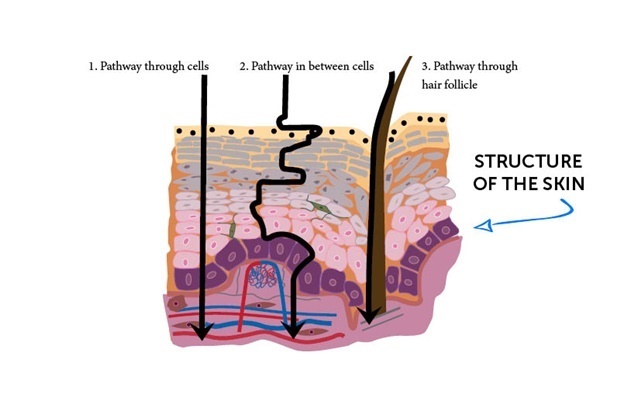In partnership with SA’s top medical aesthetic companies
The skin acts as a barrier to outside factors like bacteria, water and chemical particles, and makes the inside of our bodies waterproof. It is our largest organ, and ensuring that it absorbs the vital ingredients in skincare products designed for replenishment and revitalisation is quite a challenge.
If the skin barrier is compromised, it becomes prone to infections and inflammatory conditions like eczema. These are serious conditions that should not be taken lightly.
One of the biggest challenges facing cosmetic companies is how to enable a beneficial chemical to penetrate the skin without causing damage to the skin barrier. Cosmetics houses have invested millions in finding out how to accomplish this feat.
Why should I care about absorption?
Not all products need to be absorbed by the skin. Skin barrier products like zinc or petroleum jelly, found for example in nappy creams, form a temporary protective film over the surface of the skin, protecting babies’ bottoms against urine and bacteria.
However, for a skincare product to have any effect on ageing, pigmentation or skin texture, it will have to penetrate your skin.
Notable barriers
There are several barriers when it comes to skin absorption. The most superficial layer of the skin, known as the stratum corneum, contains a network of proteins and oils, which form a physically partially-permeable barrier. The epidermis itself is about 20 layers thick, so products that make it past the stratum corneum have to penetrate even further before reaching the dermis.
Your skin also has a number of chemical mechanisms that block chemical absorption. The acid pH of the skin is designed to neutralise alkaline substances, the fatty lipid layer in the stratum corneum repels anything which is water-based, and lymphatic and vascular drainage in the dermis rapidly removes foreign particles.
So how does a product actually get absorbed?
Despite what may seem like insurmountable barriers, some skincare products do actually manage to penetrate your skin.
Some products contain “chemical enhancers” (e.g. ethanol, acetone and sodium lauryl sulphate) that are designed to extract natural lipids in the skin, essentially breaking down the skin barrier, which allows the penetration of chemicals. Unsurprisingly, these products can damage the skin in the long run and cause severe irritation. In fact, most dermatologists will advise against using any product containing SLS or sulphates.
Fortunately newer, safer mechanisms to allow skin penetration have been invented. Certain peptides have been discovered which allow biochemical enhancement. These ingenuous products cause temporary disruption in the skin barrier, allowing chemicals to penetrate.
Another revolution in skincare is the invention of liposomes. Liposomes are a form of nanotechnology that allows chemicals to be encapsulated in a lipid bilayer, mimicking the body’s own membrane structure. Chemicals encapsulated in this way are similar enough to the skin to penetrate all the way to the dermis. There the fatty layer breaks down, releasing the chemical where it’s needed.
Nanoparticles are the current buzzword in modern skincare. Essentially, chemicals that are very, very small (less than 500 daltons) are able to squeeze past between structural proteins in the stratum corneum and epidermis. Other nanoparticles are absorbed via hair follicles. Most active ingredients cannot be physically reduced to this tiny size, so research is ongoing.
How skincare products are absorbed into the skin

Lastly, slightly more painful and expensive, but very effective ways of penetrating the skin include injections, microneedling, micro-dermabrasion, thermal ablation and chemical peeling.
Getting product where you need it
When reading the ingredient list of a promising skincare product, ask yourself whether it’s going to actually soak in where it’s needed, or just remain on the surface of your skin. Good skincare is more than the right labels – it’s about results.
Nanotechnology at work
DermaQuest ZinClear SPF30. This product includes some interesting botanicals. Imperata Cylindrica, also known as cogongrass, is an antioxidant and astringent. Arabidopsis extract (a delicate flowering plant related to cabbage and mustard) may be able to repair DNA. It also contains a number of vitamins which makes this sunscreen nourishing as well as protecting. It’s expensive, but definitely better than most of the sunblocks you’re likely to find at your local pharmacy.
Skinceuticals Physical Fusion UV Defense SPF 50 contains micronised zinc oxide spheres that thinly disperse over the skin – avoiding the ugly greyish finish found in most sunscreens containing zinc and titanium.
Lamelle Dermaheal range contains nano-encapsulated epidermal growth factors which ensure that they penetrate to the dermis, where they stimulate collagen restoration and synthesis.
Obagi Professional-C Serum 5% and 10% contains vitamin C encapsulated in a biphasic base, protecting it from rapid oxidation in the skin. This allows for longer acting antioxidant effects.
Neostrata Resurface range contains glycolic acid in an encapsulated format. This allows glycolic acid to penetrate more deeply into the epidermal layer – exfoliating dead cells and rejuvenating collagen without itchy redness.
Sources:
• Bolognia, J. Dermatology. 3rd Edition. 2009.
• Lohani, A et al. Nanotechnology-based cosmeceuticals. ISRN Dermatology; Vol. 2014
• Rahimpour, Y et al. Liposomes in cosmeceutics. Expert Opin Drug Deliv. 2012 Apr;9(4):443-55.
Take the quick Beyond Beauty Survey and you could win a R2000 Skin Renewal voucher to spend in our online store, with free delivery within South Africa. T&Cs apply.